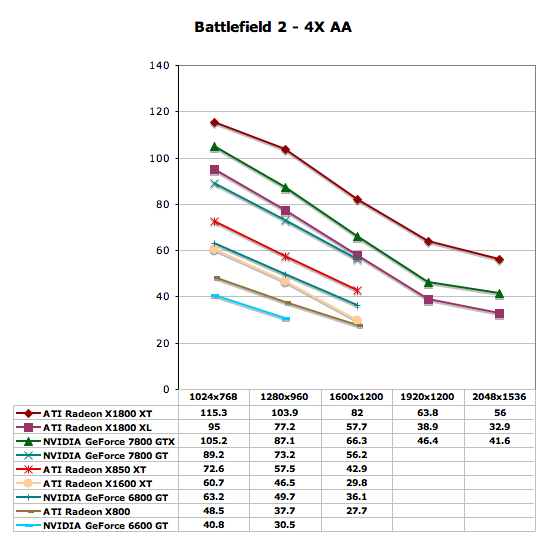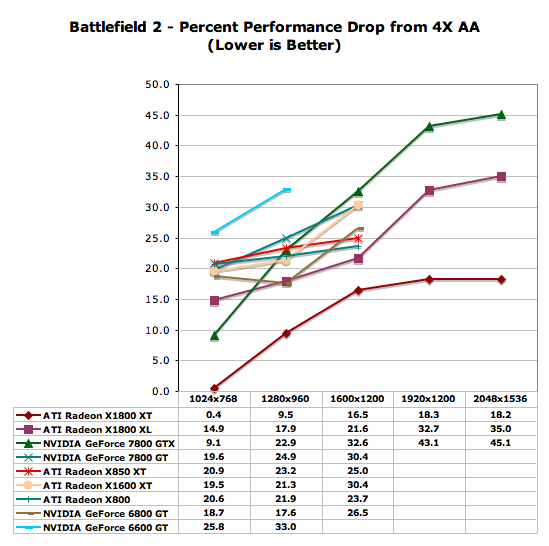ATI's X1000 Series: Extended Performance Testing
by Derek Wilson on October 7, 2005 10:15 AM EST- Posted in
- GPUs
Battlefield 2 Performance
The most requested game that we didn't include in our initial coverage is Battlefield 2. This highly popular game is quite important in comparing performance, as it does an excellent job of setting the standard for first-person shooter quality. The numbers that we attained came from running our custom BF2 demo on the highest quality settings. This means that anisotropic filtering was enabled both with and without AA (as Doom 3's high quality mode also enables AF).
Our "no AA" performance numbers show the X1800 XT performing on par with the 7800 GTX until we move beyond 1600x1200. The 7800 GT has an advantage over the X1800 XL as well. The most important thing to note is that this is the only test that we have run to show the X1600 XT performing on the level of the GeForce 6800 GT. While it is good to see the new mid-range part performing in its price class, one title is not enough to make it worth the $250. The "budget" X1300 doesn't quite perform as well as the 6600 GT, which looks to sell at about the same price.

After enabling 4xAA on Battlefield 2, the X1800 XT really stretches its legs. Likewise, the X1800 XL jumps ahead of the 7800 GT. When we move to the X1600 XT, the numbers show it falling further behind the 6800 GT.

The X1800 XT bearly breaks a sweat when AA is enabled dropping at most 18.3 percent. In fact, at every resolution, the X1800 XT drops about half the percent decrease in performance as seen on the 7800 GTX explaining the change in leadership between our two tests. Dropping more than the 6800 GT and less than the 6600 GT (percentage-wise), the X1600 XT shows different characteristics than its heavier hitting siblings.

Next up is Day of Defeat: Source. We already had a peak at this game's performance earlier this week. Now, let's see if our extended data supports what we saw then.
The most requested game that we didn't include in our initial coverage is Battlefield 2. This highly popular game is quite important in comparing performance, as it does an excellent job of setting the standard for first-person shooter quality. The numbers that we attained came from running our custom BF2 demo on the highest quality settings. This means that anisotropic filtering was enabled both with and without AA (as Doom 3's high quality mode also enables AF).
Our "no AA" performance numbers show the X1800 XT performing on par with the 7800 GTX until we move beyond 1600x1200. The 7800 GT has an advantage over the X1800 XL as well. The most important thing to note is that this is the only test that we have run to show the X1600 XT performing on the level of the GeForce 6800 GT. While it is good to see the new mid-range part performing in its price class, one title is not enough to make it worth the $250. The "budget" X1300 doesn't quite perform as well as the 6600 GT, which looks to sell at about the same price.

After enabling 4xAA on Battlefield 2, the X1800 XT really stretches its legs. Likewise, the X1800 XL jumps ahead of the 7800 GT. When we move to the X1600 XT, the numbers show it falling further behind the 6800 GT.

The X1800 XT bearly breaks a sweat when AA is enabled dropping at most 18.3 percent. In fact, at every resolution, the X1800 XT drops about half the percent decrease in performance as seen on the 7800 GTX explaining the change in leadership between our two tests. Dropping more than the 6800 GT and less than the 6600 GT (percentage-wise), the X1600 XT shows different characteristics than its heavier hitting siblings.

Next up is Day of Defeat: Source. We already had a peak at this game's performance earlier this week. Now, let's see if our extended data supports what we saw then.










93 Comments
View All Comments
bob661 - Friday, October 7, 2005 - link
1280x960 is actually in keeping with the 4:3 aspect ratio. 1280x1024 actually stretches the height of your display although it's a little hard to tell the difference.TheInvincibleMustard - Friday, October 7, 2005 - link
The actual physical dimension of a 1280x1024 screen is larger than a 1280x960 if the pixel size is the same -- there's no "stretching" of anything, as 5:4 is just more square than 4:3 is but you've got more pixels to cover the "more squareness" of it.-TIM
DerekWilson - Friday, October 7, 2005 - link
It would be more of a squishing if you ran 1280x1024 on a monitor built for 4:3 with a game that didn't correctly manage the aspect ratio mapping.The performance of 1280x1024 and 1280x960 is very similar and it's not worth testing both.
TheInvincibleMustard - Friday, October 7, 2005 - link
True enough, but most 17" and 19" LCD monitors (the monitors in question in this line of posts) are native 1280x1024, and therefore no squishing is performed.I do agree with you that it is redundant to perform testing at both 1280x1024 and 1280x960, as those extra ~82,000 pixels don't mean a whole lot in the big picture.
-TIM
JarredWalton - Saturday, October 8, 2005 - link
Interesting... I had always assumed that 17" and 19" LCDs were still 4:3 aspect ratio screens. I just measured a 17" display that I have, and it's 13.25" x 10.75" (give or take), nearly an exact 5:4 ratio. So 1280x1024 is good for 17" and 19" LCDs, but 1280x960 would be preferred on CRTs.TheInvincibleMustard - Saturday, October 8, 2005 - link
By Jove, I think he's got it! :D-TIM
bob661 - Friday, October 7, 2005 - link
That might explain why I can't tell the difference. Thanks much for the info.intellon - Friday, October 7, 2005 - link
bang on with the graphs in this article... top notch. I guess the difference in performance of these cards make it less congested.On another note, I was wondering would it be too much hassle to set up ONE more computer with a mass sold cpu (say like the 3200+) and a value ram and just run couple of the different game engines on it, and post how the new cards perform? You don't have to run this "old" setup with every card ... just the new launches. It would be much helpful to common people who won't buy the fx55.
I for one, make estimates about how much slower the cards would run on my comp, but those estimates could be much better with a slower processor.
I understand that the point of the review is to let the gpu free and keep the cpu from holding it back, but testing with a common setup is helpful for someone with limited imagination (about how the card will run on their system) or not so deep pockets.
Of course you can just go right ahead and ignore this post and I won't complaint again, but if you do add such a system in the next review (it just has to be run with the new cards) I'll be the one who'll thank you deeply.
Sunrise089 - Friday, October 7, 2005 - link
2nd, even if only for a few testsLoneWolf15 - Friday, October 7, 2005 - link
One other factor in making a choice is that there are no ATI X1000 series cards available at this point. Once again, every review site covered a paper-launch, despite railing on it in the past. No-one is willing to be the first to be scooped and say "We won't review a product that you can't buy".I have an ATI card myself (replaced a recent nVidia card a year ago, so I've had both), but right now I'm pretty sick of card announcements for cards that aren't available. This smacks of ATI trying to boost its earnings or its rating in the eye of its shareholders, and ignoring its customers in the process. It's going to be a long time before I buy a graphics card again, but if I had to choose a vendor based on the past two years, both companies' reputations fall far short of the customer service I'd hope for.